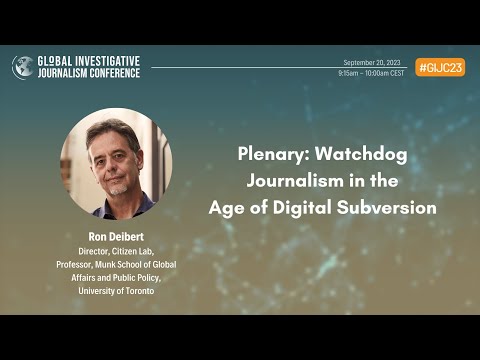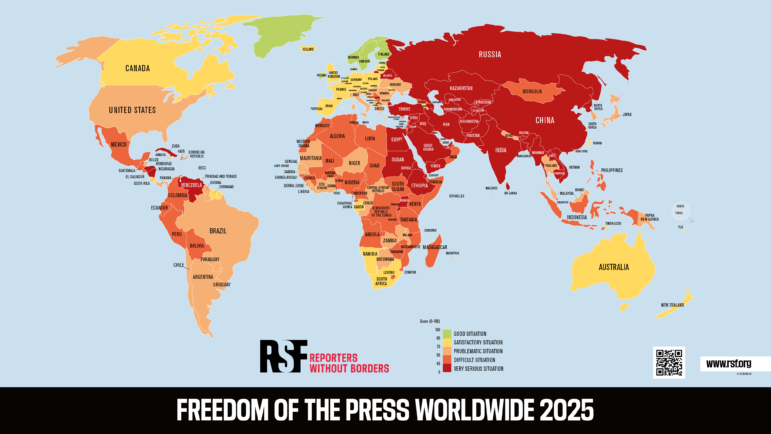

Image: Screenshot, Harry Evans Summit, YouTube
Journalism in the Crucible: Seven Key Takeaways from 2025 Harry Evans Truth Tellers Summit
Harry Evans was at the helm when the Sunday Times Insight team investigated how the morning sickness drug thalidomide had caused severe birth abnormalities in children.
His reporters also uncovered the British diplomat Kim Philby’s decades as a Soviet spy — their investigation revealed that the defector had even been a Russian mole while serving as chief of anti-Soviet operations for British intelligence.
Upon his death, at the age of 92, he was remembered as a fearless editor and a champion of just causes. The New Yorker’s Adam Gopnik wrote that Evans had a relentless curiosity, which spurred his determination to find out the truth.
“Not the official truth or the acceptable truth or the cosmetic truth but the unvarnished reality of significant events,” he wrote.
At the 2025 Truth Tellers Summit in London, held to commemorate Evans’ legacy, investigative reporters, newsroom leaders, and editors discussed their investigations into Russian prisons, online pornography sites, and corruption. A photographer from Gaza spoke about the personal toll of taking images that told the world what was happening to the civilians on the ground. Others discussed the challenges of the current media landscapes: from legal assaults to physical threats, and from the challenges presented by media-skeptic Donald Trump in the White House to the ever-growing challenges of meeting your audiences where they are. Here are seven things we learned.
1. Should the Press ‘Fight or Fold’ Under Authoritarian Pressure?
Many speakers spoke to the worsening press climate in the United States since the start of the second Trump administration.
“There is this incredibly difficult dynamic the press is in. This time it’s not just words with Trump, it’s actions,” said Brian Stelter, CNN chief media analyst. “There are some owners — not all — who are trying to figure out a path forward that seems like appeasement.”
But even within organizations, he explained, there is a fractured picture as reporters, owners, and editors try to work out the best way to respond.
“Sometimes [there is] fighting and folding in the very same place… at CBS right now some are fighting, others are folding — it’s happening in the exact same house. For every outlet that does fold others are going to fight,” he said.
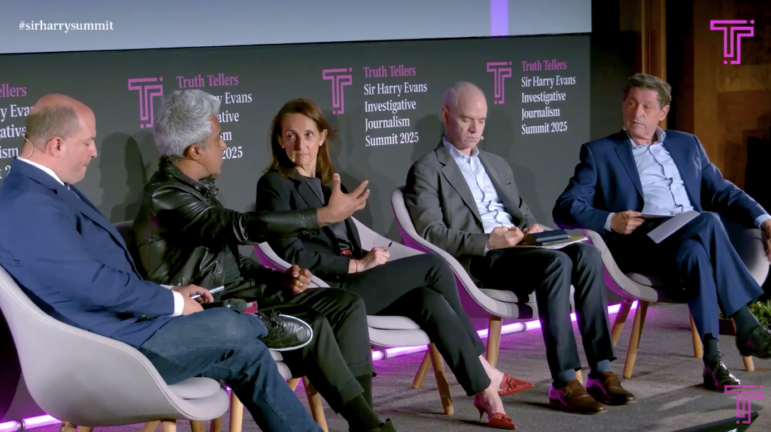
Former New York Times correspondent Anand Giridharadas (second from left) speaking at the ‘Will the Press Fight or Fold?’ panel at the Harry Evans Summit. The session also included (from left to right) CNN media analyst Brian Stelter, Reuters Editor-in-Chief Alessandra Galloni, NYT Executive Editor Joe Kahn, and moderator Jon Sopel. Image: Screenshot, Harry Evans Summit, YouTube
While Stelter said he was uncomfortable with the terminology, reporters need to stand up for themselves.
“The word fight makes me uncomfortable. Inherently. We are talking about ‘fight or fold.’ I don’t think of myself as a fighter. I don’t think most reporters who are covering politics or media feel they are at a fight… and yet if one side is at war and the other side is not at war, the other side loses. A pacifist always loses in a war,” he warned.
Alessandra Galloni, the editor in chief of Reuters, also issued some words of caution.
“This is not a fight. Our responsibility is to our audience. Our audience wants news, they don’t want a fight… The minute we make it about us versus the White House or us versus anyone else we are doing them a disservice,” she said. “Many studies have shown that when journalists have made it about themselves — to air their dirty laundry — that diminishes trust.”
She added that while there is a sense of “a certain end to American exceptionalism here,” what is happening in the US is not unusual.
“We work in 100 countries around the world. This is a playbook we have seen around the world. I don’t want to diminish what’s happening in the US… but journalists can still do their job in the US and do it every day very successfully.”
The investigative reporter Christo Grozev, said he “no longer feels as safe as I did” in the US, a view echoed by the media lawyer Caoilfhionn Gallagher, who said that a number of journalists who are “immigration uncertain” — or non-US citizens — now feel vulnerable.
“Journalists in exile who have fled one regime and sought sanctuary elsewhere. They are people who have made their home in London, Washington, DC, New York, journalists who are honing their craft and continuing to do their job,” she said. “What we are now finding in the US is that many people feel it’s no longer a place of sanctuary.”
She said reporters are now having to consider using burner phones and taking steps to make sure they are safe to enter the US — the kind of tactics journalists once used for places like Saudi Arabia and the Philippines. “These are issues we are having to think about in the West now as well,” she said.
2. Brave Journalists Take Enormous Risks to Get the Story Out
Grozev, who works for The Insider, and Armando.info’s Roberto Deniz detailed the specific investigations that led to their being forced to live in exile.
“I started investigating Russian Intelligence services in 2014,” Grozev recalled. “But I never felt or saw any evidence of any threat to my life until the Navalny investigation. It seems that was the trigger that changed things for Putin.”
As he was speaking, in a courtroom in another part of London, a judge considered the sentences for a group of people accused of spying for Russia and conspiring to kidnap him — they were jailed just a few days later.
“The initial intent was to surveil me. Find out my sources. Prove, for the FSB, that I’m not a journalist, that I’m somehow getting material from the intelligence services,” he explained. “When they didn’t find that, it exasperated everybody all the way up the food chain to Putin. So they decided maybe the next thing to do is kidnap [me] and take [me] back to Russia. At one point they decided it’s easier to kill [me].”
The barrister Caoilfhionn Gallagher, who represents some of the most high-profile and at-risk reporters around the world, pointed out how some journalists are now under threat wherever they are.
“No matter where in the world Cristo is, they are determined to chase after him. That’s increasingly a trend we are seeing. We now live in a world in which Jamal Khashoggi, a Washington Post columnist, can be dismembered in a Council of Europe state country [Turkey]. In which a Ryanair plane can be hijacked in order to forcibly bring someone within jurisdiction. In which diaspora communities here in London are terrorized,” she cautioned. “Autocratic regimes trying to silence journalists and stop their work is not unusual. What’s now turning into a systematic tool in autocratic regimes’ weaponry is the long arm of the state targeting journalists wherever they may be.”
When Deniz was first forced to leave Venezuela — for his investigation into a controversial aide to President Nicolas Maduro — he thought he would be gone for a few months. That was in 2018. He is still living in exile.
“I have two orders of arrest in Venezuela for this investigation,” he told the audience, about the multi-million dollar aid scandal he investigated.
A documentary about his work — “A Dangerous Assignment” — was recently nominated for an Emmy Award in the Outstanding Investigative Documentary category.
“The most important thing is this documentary and investigation reveals the real nature of the Maduro regime. When Venezuela was suffering its worst eco-social crisis this guy… because he was in the inner circle of Nicolas Maduro, was making money,” Deniz said.
3. Investigative Journalism is Expensive — But Priceless
Galloni, whose teams have won multiple awards for their investigations, said that while watchdog reporting can be expensive, it’s worth it. “All of our money — every single cent — that we spend on investigative journalism is not wasted,” she said.
Justin Scheck, a reporter at The New York Times, was part of a team that investigated how women going to work as domestic service staff in Saudi Arabia faced physical mistreatment and violence at the hands of their employers. He said that they had only been able to do the piece because of the backing of their editors and generous funding.
“This story was expensive. We had to make repeat trips to rural parts of Kenya and Uganda… if we didn’t get what we needed, we were able to go back. That’s something we were very lucky to have,” he explained. “We are very privileged to work at an organization that is healthy enough financially that we didn’t feel any pressure.”
But, he told the audience, investigations like these bring dividends — the piece was the most-read international story in the first quarter of this year. “It’s not like the money invested in the story was charity,” he said. “People read it.”
On a separate panel, Andrew Lack, the former chairman of NBC News and the founder of digital-first local investigative news organization Mississippi Today, which won a Pulitzer Prize in 2023, said “there never was a more crucial time to be chasing investigative reporting, particularly in local news.”
He said that funding comes when you have a reputation for good quality investigative journalism, by sharing the facts with your audience, and “making your case over who you are and what you are doing” to potential funders.
The Bureau of Investigative Journalism CEO, Rozina Breen, said that while many investigative reporters share her somewhat romantic view that “we are here driven by a moral purpose and a duty,” these days investigative journalists also need to be creative in how they do their jobs.
“Money is a factor,” she said. “You learn to hustle. There’s a determination to find every which way to keep going. You have to find ways to keep going… We are not driven by the people that give us the money but by what we have to do, and there’s a lot to do right now.”
4. Even ‘Black Boxes’ Can be Investigated
“One thing people should know about me is I get very excited about heavily redacted documents,” said Linda So, an investigative reporter at Reuters, who together with her colleague Andrew R.C. Marshall published a recent investigation into the adult-only website OnlyFans.
Their seven-part series led them to find “various forms of illicit activity on OnlyFans. Child sex abuse material… 120 cases of non-consensual or revenge porn… we also uncovered cases of sex trafficking,” So told the audience.
Among the victims they found was a woman forced to make sexual content by her partner, who made US$422,000 from the abuse, sharing only $2,000 with her.
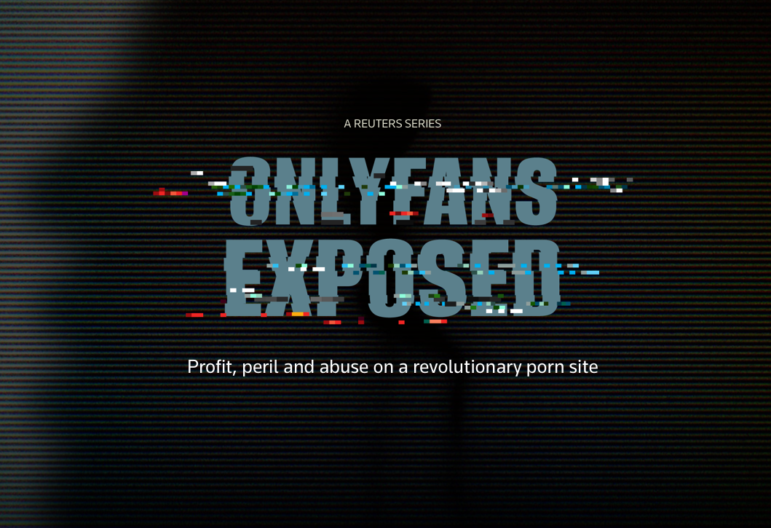
The reporting team that investigated child sex abuse material and trafficking on the adult site OnlyRans discussed their methodology. Image: Screenshot, Reuters
While there are four million content creators on the site, according to Marshall, “nearly all of it is behind a paywall. That makes it extremely hard for journalists and law enforcement safety experts… it’s kind of a black box.”
The way they tackled it was to use police records, and at the heart of the project, Marshall said, was an information request to 300 law enforcement agencies that gave them leads to witnesses, suspects, and perpetrators, and enough material to build a database.
According to So, the story that looked at child sex abuse was probably the most complex.
“Often the biggest challenge was that the documents that dealt with cases of child sex abuse and minors were very heavily redacted,” she explained. “But behind those redactions are stories people need to know about.”
(An OnlyFans spokesperson said misuse of its platform is rare — and that moderation was helping them to keep users safe.)
5. Reaching Audiences Remains a Challenge
Anand Giridharadas, a former foreign correspondent for The New York Times and the publisher of The Ink newsletter, said that, in a fractured media landscape, the question of whether audiences trust reporters is becoming increasingly crucial.
“I would start with this paradox — whether it’s independent media, The New York Times, or television – I think our profession is doing some of the best work it’s ever done. And in the eyes of the people we serve, we are failing them a lot of the time,” he pointed out. “We’re as trusted as political parties people hate, as governments people don’t trust to help them anymore. It’s an age of mistrust in general, but given the risks people take every day in our profession, given the fact that their bodies and lives are on the line, given the dogged work for low pay we do holding people like Donald Trump to account… The fact that we are not trusted by most people in most places — it’s an enormous problem.”
He added that there is partly a problem with formats — the type of journalism he was trained in at the Times is, he said, no longer sufficient. “There are elements of the old form of how we tell the news that simply don’t work anymore.”
He also said that the “archipelago of paywalled content” that exists at the moment is not enough to deal with the crises the media is facing. “We need to show our work. A lot of the public has no idea what reporters actually do… we need to show our work, share our process, and that’s part of rebuilding trust.”
The NYT’s executive editor, Joe Kahn, noted that this strategic shift is part of their current approach at the Times — “trying to put our journalists more front and center.”
“The people actually doing the hard reporting and thinking through the issues are part of the story and telling the story,” he said. And on tone: “We are speaking in more conversational language… moving away from the inverted pyramid of the old newspaper story to a form of journalism that speaks more directly to what people need to know.”
Kahn said that while there are “ecosystems and silos that are hard to break through,” even the Times — which has a reputation for being favored by liberals — has “a large number of readers and subscribers in red states and even the reddest counties in the US, and we can do journalism that reaches them.”
The Venezuelan filmmaker Juan Ravell — who started working with Armando.info in 2018 — said that while in many traditional media formats there was a sense “that you don’t show how you make the sausage,” he thinks the reverse is now true.
“The feeling a journalist gets when he or she uncovers something,” he said, “with storytelling you can show that and have that same effect” in the audiences you want to reach.
6. Consider Alternative Platforms, Learn from YouTubers, Know What Stories Your Audiences Care About
Dhruv Rathee is an Indian YouTuber with 28 million subscribers. He said that in India, alternative platforms had provided an outlet and an opportunity for people like him and for reporters who have opted out of the legacy media outlets where they have less independence.
“I’m more of a YouTube educator and content creator than a journalist,” he said during his session, referencing a recent video of his entitled “Is India becoming a dictatorship?”
But he said, the platform is also becoming a vital outlet for journalists, too.
“YouTube is really turning out to be quite a platform for the fourth pillar in India,” he explained. “There are journalists that used to be employed by the legacy media that have now shifted to YouTube. It helps them break away from this financial model of being dependent on government funding.”
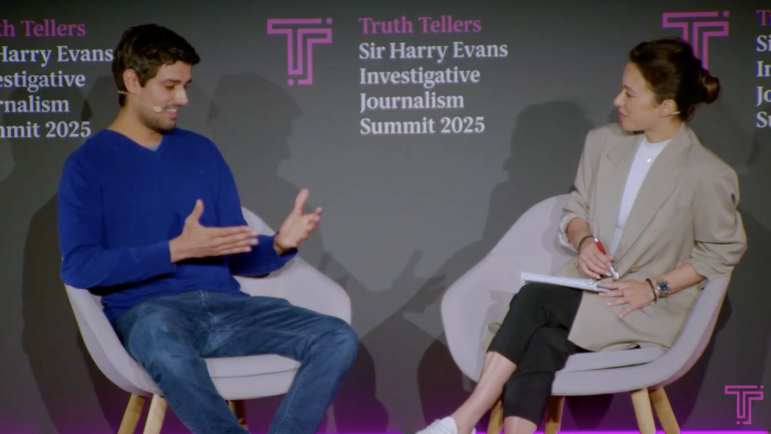
YouTube influencer Dhruv Rathee discusses with moderator Isobel Young, from CNN, the legacy media in India and how to reach new audiences with video. Image: Screenshot, Harry Evans Summit, YouTube
Talking about story selection, he said he uses a matrix to assess which stories to cover: “I’m one person. I can only make six or seven, maximum eight videos in a month,” he said, so he asks himself: How passionate do I feel about this topic? How helpful will this be for my audience? Is it adhering to my values? And is this being covered enough in the mainstream media?
The results of coverage self-assessment help him decipher if “this is something I should pick up or is this is something I should leave.”
Christo Grozev said he had learned from his children about the importance of using new platforms to widen your audience. “My kids told me: ‘Your investigations are only read by people who already believe what you are saying. If you want to have an impact, let us make short videos [about the stories],’ and that’s what is happening now.”
7. Sometimes a Blockbuster Story Just Comes to You — Be Ready
The editor-in-chief of the Atlantic was driving when his phone pinged — he had been added to a new Signal group that appeared to contain the US vice president, Defense Secretary Pete Hegseth, and the national security advisor, as well as other members of the Trump cabinet. “Bombers are launching in an hour,” a message said. He pulled over.
He was pretty sure it was a bluff, but since the chat had been set up to discuss an apparent impending strike on Yemen, he realized he wouldn’t have to wait long to find out.
“I thought to myself, in two hours I’m either going to find out if this is an elaborate fake, someone trying to entrap me, which was what our operating assumption was the whole time, simply because this is too stupid to be believed. This can’t happen, so it has to be an elaborate deception operation,” he said. Or else he would find out it was true.
When the attack started at the time the messages predicted, he realized not only had he been included in what was supposedly a top-secret group, but also that US officials were using unofficial messaging channels to discuss military operations.
“By that Sunday, I, and the company, had national security lawyers, First Amendment lawyers, and criminal lawyers,” he said. He realized that the “ethical thing to do was leave the chat and let them know I was going to leave… There were exposures we didn’t want to necessarily play with.”
He was not initially sure how to handle the content he had been told about, but once the White House started to attack him — saying he was “lying about what was in the chat” — he said they “had to put it out.” The resulting story — The Trump Administration Accidentally Texted Me Its War Plans — was a huge scoop, but an unconventional one.
“This is not an Edward Snowden type of situation where I have a source leaking me information,” said Goldberg. Instead, it was “I’m just going to wait for someone to send me something. Like many reporters in this audience, I’ve probably driven a thousand miles across a war zone to get a quote from someone who wasn’t there. We do a lot of work often to get very little. And here I’m like… ‘Keep going Pete!’”
His takeaway from the whole episode? “The only way to operate in this environment is to refuse to be bullied. And refuse to be scared. When you push back and the truth is on your side then fine… I think we live in an incipient authoritarian climate, but we can still publish what we want to publish.”
Goldberg also encouraged reporters to continue to dig deep into misconduct of all kinds, to keep covering the “things that shock the conscience.”
“As journalists, you can have sleepless nights or you can give other people sleepless nights. At the end of the day we need to keep the focus… eventually the truth will prevail.”
 Laura Dixon is a senior editor at GIJN, based in the UK. She has reported from Colombia, the US, and Mexico, and her work has been published by The Times, The Washington Post, and The Atlantic, among others. She is a former staff reporter of The Times in London, and has received grants and fellowships from the IWMF, the Pulitzer Center, and Journalists for Transparency.
Laura Dixon is a senior editor at GIJN, based in the UK. She has reported from Colombia, the US, and Mexico, and her work has been published by The Times, The Washington Post, and The Atlantic, among others. She is a former staff reporter of The Times in London, and has received grants and fellowships from the IWMF, the Pulitzer Center, and Journalists for Transparency.




